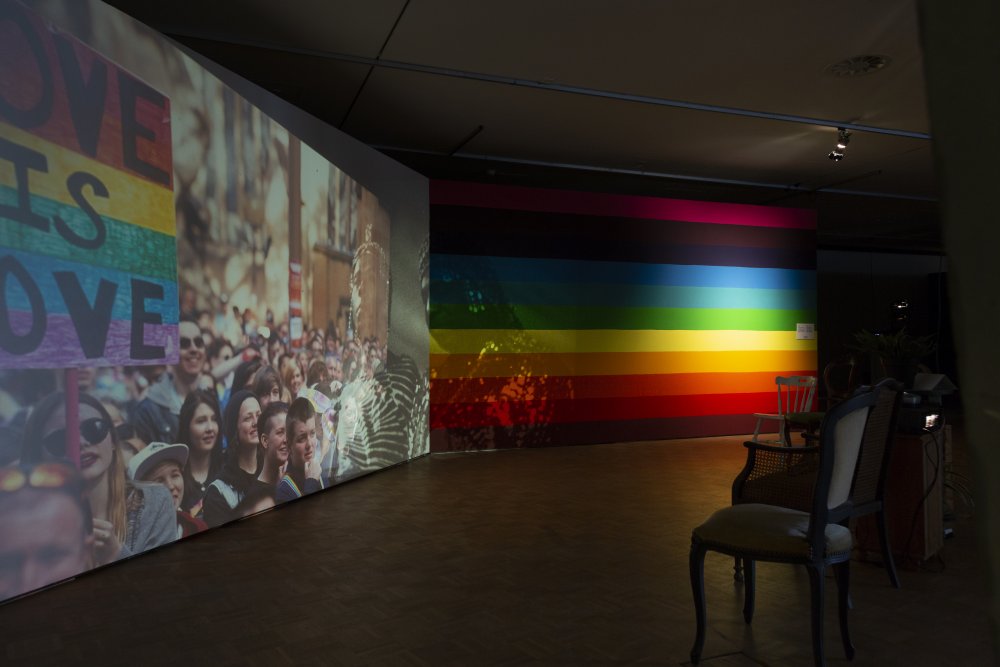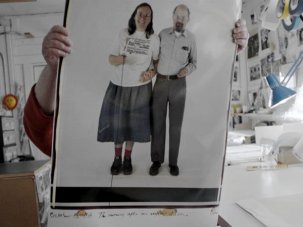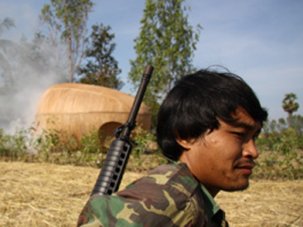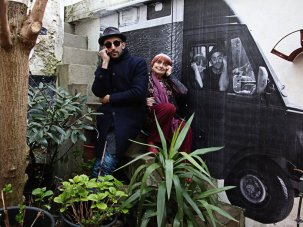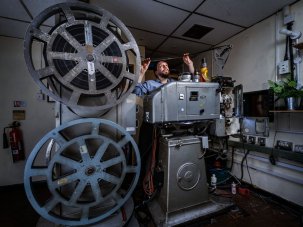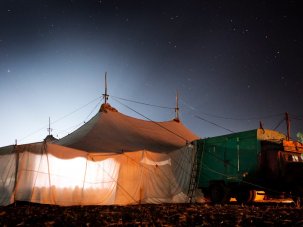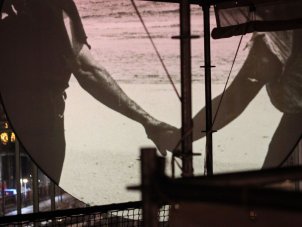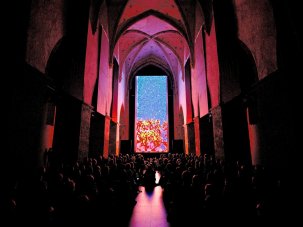Manufactured in 1961, Kodak’s first carousel slide projector, the Model 550, added a rotary tray fitting onto a standard 35mm slide projector. This allowed for motorised ‘slideshows’, images that could pass in sequence without user input, slide-cycles that snap together producing something resembling a film – if a very slow one. While not a new invention, Kodak’s product offered a number of advantages over competitors’ – not least affordability and reliability – and it quickly became a feature in galleries, performances, archives and lecture halls, as well as in the home.
Blackout is part of Julian Ross’s research supported by the Leverhulme Early Career Fellowship at University of Westminster. A variation of the exhibition will be held in March 2019 at Ambika P3, London, and in April 2019 at Greylight, Brussels.
Fast forward to 2004, and after more than seven decades of production and 35 million in sales, Kodak Eastman manufactured its last carousel slide projector. The end of an era was signalled by the sound of a revolving motor and the signature click-click-snap. There was a ‘farewell party’ at George Eastman House, in Rochester, New York, at which a few words were said and vintage models distributed to employees. A filmmaker was in attendance – she is making a documentary about the history of slide projectors. A death knell was rung, life carried on.
This is the point at which Blackout – an exhibition that took place as part of the 2019 edition of the International Film Festival Rotterdam – begins, with works for carousel slide projectors produced after the date that Kodak’s device was discontinued. Curated by festival programmer Julian Ross as part of his Leverhulme Trust research project, it included 11 slide projector installations in the Kunsthal Rotterdam, as well as a number of new slide-based musical performances in the festival’s nighttime venue WORM, and a travelling one from multidisciplinary artist Cauleen Smith that took place within the walls of the Kunsthal itself.
Blackout shows how artists continue to use technologies long after their manufacturers have declared them obsolete. The title has two meanings. The first references “the intermittent moments of darkness between the projected slides”, the dark gaps between the light that are distinct to this mode of projection and lend it its drama. The second refers to the overlooked histories that the artworks explore. In resistance to what Ross’s introductory text calls “historical amnesia”, the installations included in the exhibition use their obsolete technology to evoke imperilled, forgotten or even forcibly erased pasts.
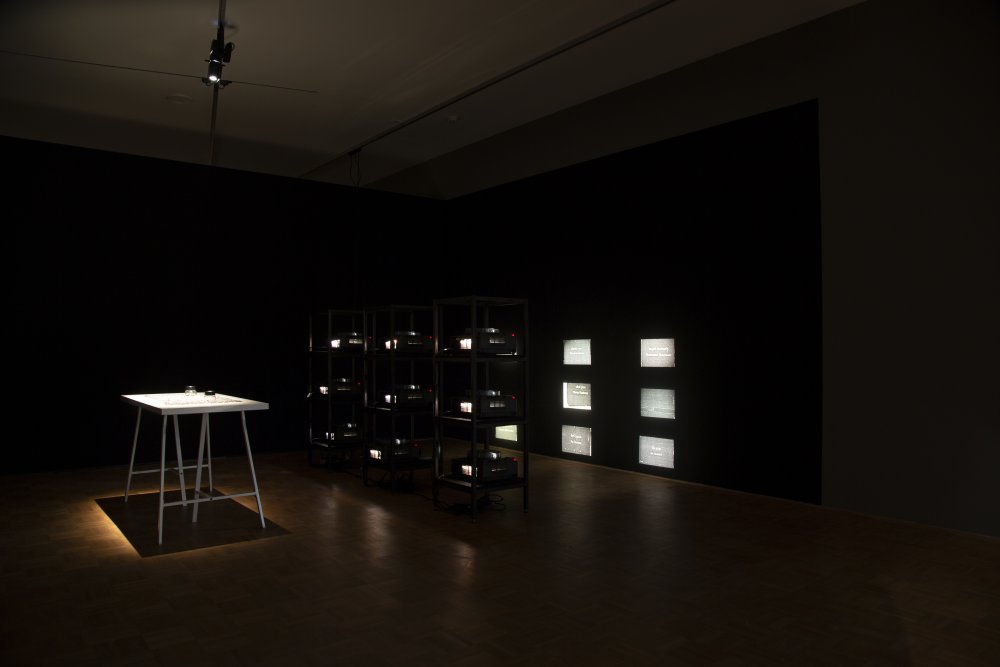
Non-Chronological History (2013)
Credit: Tomas Mutsaers, International Film Festival Rotterdam
One piece does this quite directly. Prapat Jiwarangsan’s Non-Chronological History (2013, Thailand) has nine projectors installed like a multi-monitor video-wall, with slides featuring the names of individuals associated with Thai political history appearing in a randomised order. Blank slides represent names of the dead that remain unknown; and the known names are stripped of their rank, role or titles of honour. No differentiation is made between perpetrator or victim; between history’s actor or its subjects.
Besides the slides, a small mountain of tiny square photographic portraits are stacked like a slag heap, the faces on the pictures just about distinguishable through a magnifying glass. “Each person in life is a particle of dust,” said Prapat at an artist’s tour of the exhibition, and his piece quickly and forcefully induces their remembrance, at once on an abstract and individual level. While arguably one of the more simplistic works in the exhibition, it was both one of the most immediately affecting, and one that has lingered in my mind since.
Similarly provocative, Hannah Dawn Henderson’s dual projector piece Between a Gaze and a Gesture (2017, UK/Netherlands) asks “how do we formulate the words to speak of history?” Drawing from the archive of Liberty – a British human rights organisation founded in 1934 – it interposes photographs, press cuttings and texts from the archive with textual intertitles written by Henderson, the two parallel projectors communicating with each other as the slides snap past.
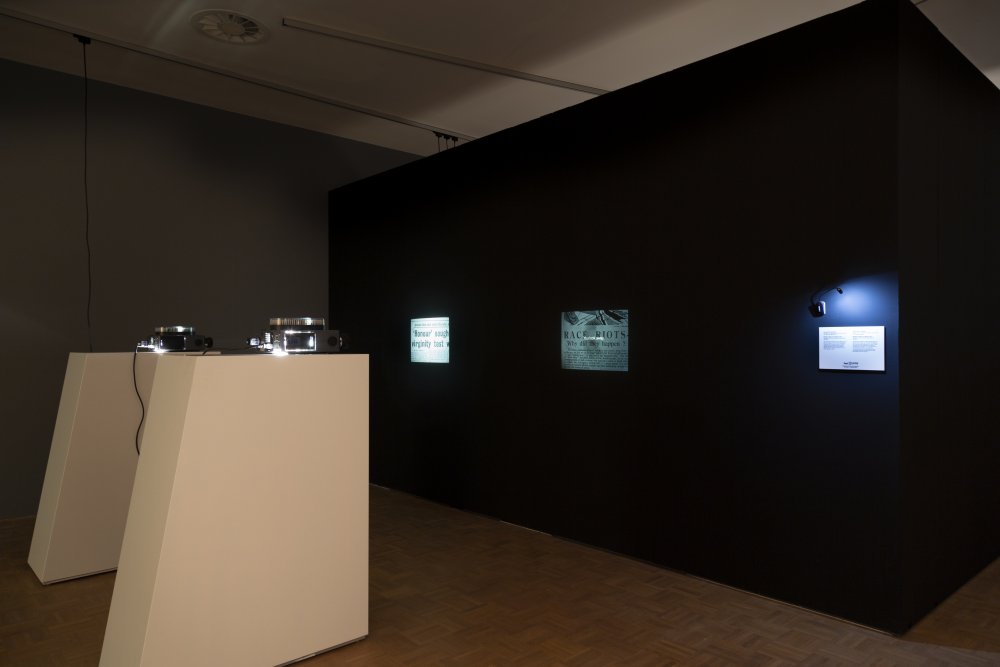
Between a Gaze and a Gesture (2017)
Credit: Tomas Mutsaers, International Film Festival Rotterdam
The results forge an astute, powerful essay on rising xenophobia and nationalism in mid-century Britain from the perspective of the marginalised communities it was directed towards. Hendersons’ queries are not abstract, but aimed directly at the viewer, addressing their gaze on the materials and implicating them in the seen and described situations.
Detailing what the artist referred to as “histories of discrimination and counter-protest”, the installation looks at the legacies of the British Empire, and the continual aggressions directed towards migrants from Commonwealth countries, as well as the ways in which they have forged a resistance. Though its sources are archival, the work seems startlingly relevant to contemporary Britain, the rhetoric found in the material entirely familiar to a country where similarly toxic attitudes towards migration remain prevalent today.
One of Henderson’s text slides asks: “Where do we go from here?” Her installation offers no answers as such, but does show that one of the best ways of addressing recent or ongoing history can be through what she called “an excavation of the archive” – looking back in order to try to understand how, or if, it might be possible to move forward.
Also engaging in a conversation with found sources, both Nguyen Trinh Thi’s Landscape Series #1 (2013, Vietnam) and Ahmad Fuad Osman’s Recollections of Long Lost Memories (2007, Malaysia) look towards the landscape for their investigations into history.
The unobtrusively ingenious Landscape Series #1 consists of a series of images of people pointing towards landscapes in the distance. Sourced from online news reportage in Vietnam, the digital images were converted into 35mm slides and sequenced into an abstruse narrative, in which countless figures are seen forlornly gesturing at various empty landscapes, the viewer never really able to grasp exactly what it is that they are gesticulating towards. Crystallisations of a single moment in time and space, presented without explanation, they make the viewer wonder what it was that preceded and followed them, what it was that made these seemingly innocuously locales become newsworthy, if only for a moment.
Like many of the works on display, it raises questions about what makes a film a film, and why an exhibition made entirely on works featuring still images has found its place within a festival dedicated towards the promotion of moving ones. “For me it is a film,” Nguyen said during the tour. “The sound of the projector moves things forward.” Of all the works included, with its experimentations with formats and its semblance of a structure, this was the piece in the show that most resembled a narrative film, the story of many lost men searching for something that remains always just out of reach.
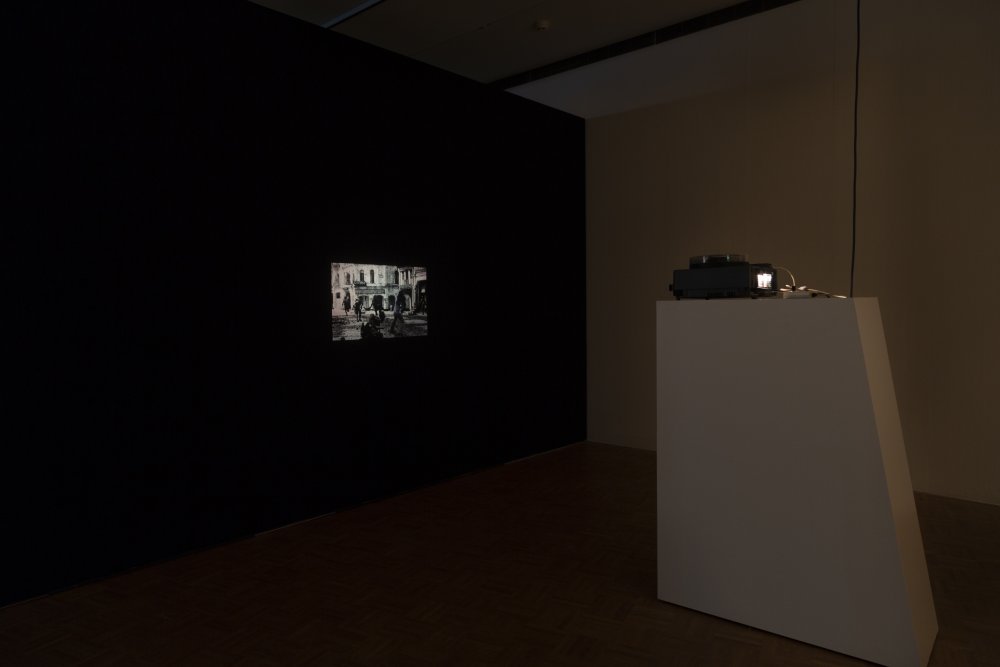
Recollections of Lost Memories (2007)
Credit: Tomas Mutsaers, International Film Festival Rotterdam
Osman’s Recollections of Long Lost Memories is just as playful, if ostensibly dafter. In this piece – also playing on a single projector – the artist inserts his friend into a series of historical photographs, his posed, performative figure cutting a contrast to the candid nature of the images. The work would almost be like a Where’s Wally book of Malaysian history, did the man’s full-colour body not make him so easily spottable within the sepia-toned scenes he is invading. Instead, he acts as a tour-guide through time, a strangely soothing constant amongst all the historical flux.
Two other highlights complimented the performances they accompanied. Raha Raissnia’s installation Mneme (2017, USA) made for a calming counterpoint to the intensity of Mneme II (2016, US) which was performed at WORM late at night. The most abstract installation in Blackout, Mneme stood out within the space. Though it did not seem to fit the exhibition’s theme of ‘historical amnesia’ at first, the accompanying text revealed why it belonged. Inspired by one of the three muses in Greek mythology, Mneme, who is ‘memory personified’, it was something like an evocation of the past as it appears in a dream – or, with its dense, dark painted slides, more of a nightmare.
Raissnia is a painter who draws inspiration from experimental filmmaking, and this work resembled early experiments in ‘direct animation’ or ‘hand-painted film’, in which the film strip itself is drawn or painted on, then projected, blown up and brought to life. Consisting of thick, dense oils and charcoals of the deepest blacks, its scenes were grim, ghostly and gloomily beautiful – bold, black assemblages perforated by backlit bursts of thickets of light.
Eye-catching in the gallery space, it was in the backroom of the club that this technique took on new life. The equally gothic Mneme II features a rapidly flickering, densely layered array of similar imagery projected onto two monolithic screens: a front sheer panel that absorbs and reflects light, and a back canvas one painted in black oil. Presented alongside doomy, industrial musical accompaniment from artist and musician Panagiotis Mavridis, performing with handmade pipe and string instruments, it was bold, bleak and very black-metal – an absolute blast.
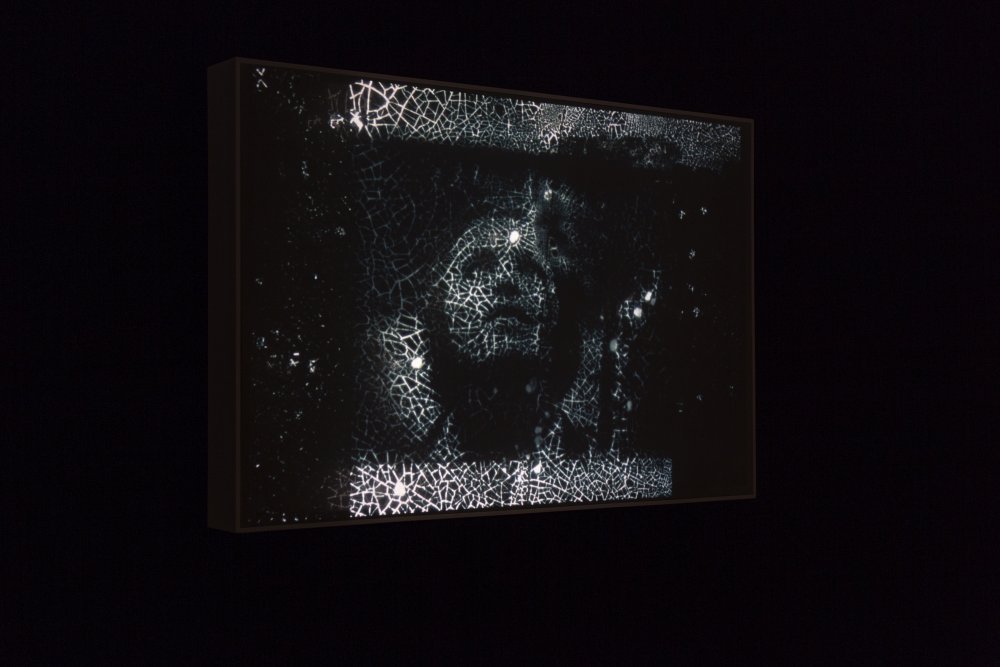
Mneme (2017)
Credit: Tomas Mutsaers, International Film Festival Rotterdam
As impressive was Cauleen Smith’s Space Station Rainbow Infinity (2014, USA), a slide projector installation which, with its accompanying rainbow painted wall mural, took up a large portion of the gallery space, and also added a pop of colour that was otherwise absent in an exhibition reliant on darkness. Installed in an inviting seated setting, with plants laid out around a constellation of chairs, it features slides that are used in her performance Black Utopia LP (2012/19, USA), a project that came out of Smith’s research at the Alton Abraham Sun Ra archives and looks into afrofuturist ideas as they appear in the experimental musician’s work and wider.
A travelling, transforming show, when Black Utopia LP was presented in the Kunsthal, Smith stood behind a turntable and slide projector setup, overlooking the audience and her projections in front of her, playing the double LP in full whilst selecting sequences of 35mm slides to match. Smith has described it as a “film without film”, and much as in Nyugen’s work, the sound of the projector as much as the music on the record moves things forward. The record plays through – a wide ranging sonic collage featuring interviews from Sun Ra, his collaborators and those he has influenced, as well as songs and performances from him and his Arkestra – and with each carousel slide snap, a new accompanying image arrives.
As images arrived in sequences – an extended montage featuring black astronauts for instance, or one involving documentation of Sun Ra’s collections of musical equipment and elaborate live performance setups – stories start to form, the viewer making connections between the image sequences they see and the aural stories heard on the soundtrack. Throughout, a sense of wonder is present, an aliveness to the possibilities of black experimental creative expression that are mixed in with Sun Ra’s speculative, interplanetary philosophies. Though Smith’s source is history, drawing as it does from the archives, her outlook is firmly focused on the future, finding in Sun Ra’s wide-reaching thoughts and beliefs an almost infinite array of potentialities or possible futures. As with other works in the exhibition, it shows that looking back in time does not mean being stuck in the past.
The carousel slide projector, an old relic lent new life, is well fit for the purpose it is put to in this exhibition, the surfacing of lost memories and forgotten pasts. Artists have been using carousel slide projectors ever since the device’s introduction, and as demonstrated here continue to do so following its supposed obsoletion. A effective synthesis of form and content, through a concise, curated collection of personal reflections on shared histories, Blackout brings the lost past back to life, one shutter snap at a time.
- Kieron Corless reports on the 2019 International Film Festival Rotterdam in the April 2019 issue of Sight & Sound.
-
The Digital Edition and Archive quick link
Log in here to your digital edition and archive subscription, take a look at the packages on offer and buy a subscription.




